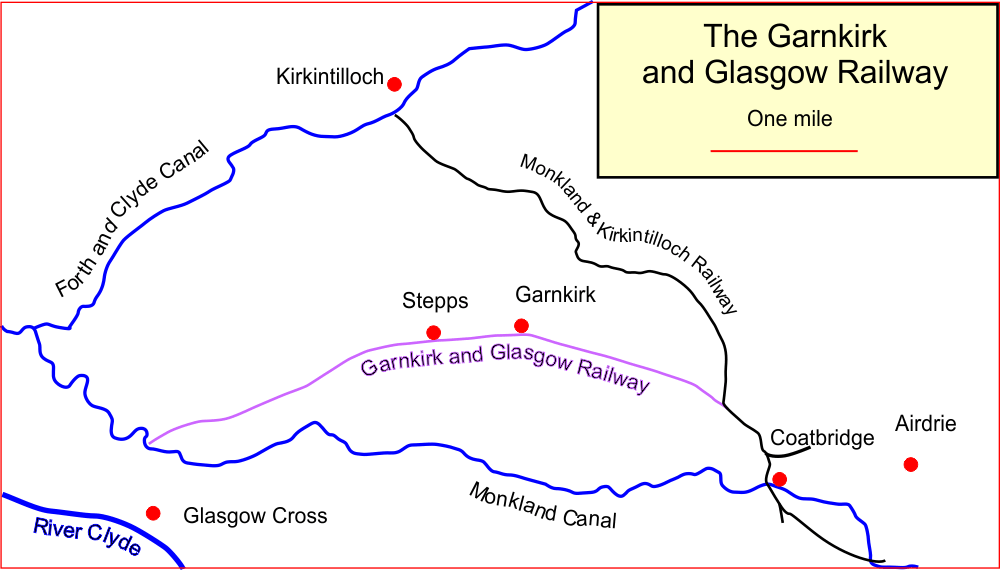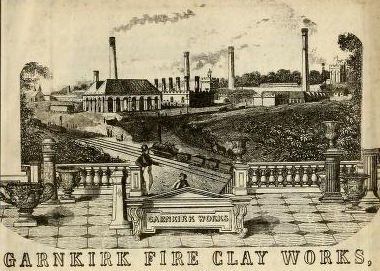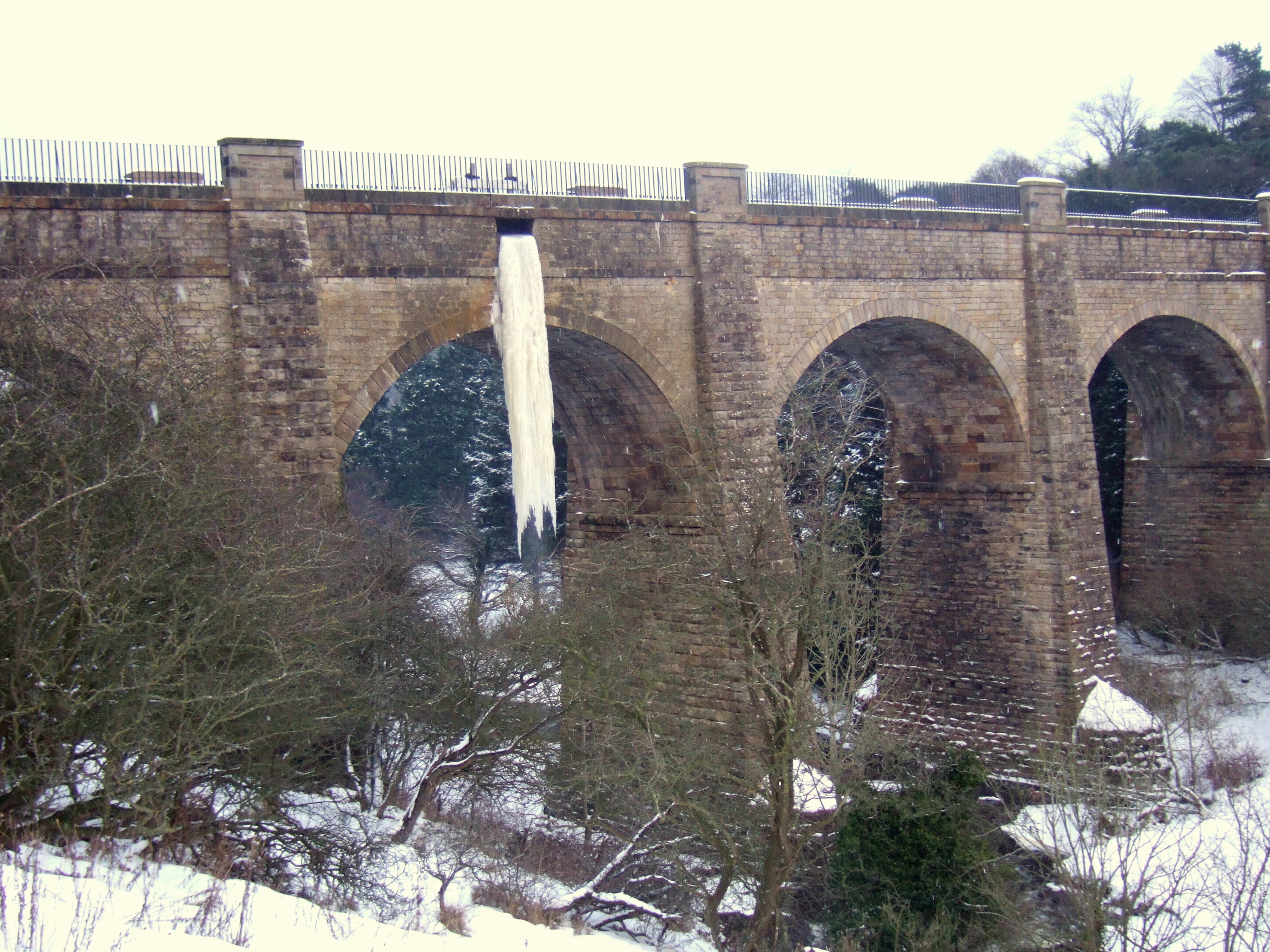|
Glasgow, Garnkirk And Coatbridge Railway
The Garnkirk and Glasgow Railway was an early railway built primarily to carry coal to Glasgow and other markets from the Monkland coalfields, shortening the journey and bypassing the monopolistic charges of the Monkland Canal; passenger traffic also developed early in the line's existence. It opened officially on 27 September 1831 using horse traction, and had the track gauge of that had been adopted by the Monkland and Kirkintilloch Railway, with which it was to connect. It was dependent on the Monkland and Kirkintilloch Railway for access to the best areas of the coalfields, but eventually it by-passed this constraint by extending its line southwards through Coatbridge, enabling a direct link with another coal railway, the Wishaw and Coltness Railway. Widening its horizons it changed its name to the Glasgow, Garnkirk and Coatbridge Railway. The track gauge originally chosen was now a limitation and it altered its gauge to the standard of . When the Caledonian Railway advan ... [...More Info...] [...Related Items...] OR: [Wikipedia] [Google] [Baidu] |
Caledonian Railway
The Caledonian Railway (CR) was a major Scottish railway company. It was formed in the early 19th century with the objective of forming a link between English railways and Glasgow. It progressively extended its network and reached Edinburgh and Aberdeen, with a dense network of branch lines in the area surrounding Glasgow. It was absorbed into the London, Midland and Scottish Railway in 1923. Many of its principal routes are still used, and the original main line between Carlisle and Glasgow is in use as part of the West Coast Main Line railway (with a modified entry into Glasgow itself). Introduction In the mid-1830s, railways in England evolved from local concerns to longer routes that connected cities, and then became networks. In Scotland it was clear that this was the way forward, and there was a desire to connect the Central Belt to the incipient English network. There was controversy over the route that such a line might take, but the Caledonian Railway was formed on ... [...More Info...] [...Related Items...] OR: [Wikipedia] [Google] [Baidu] |
Gartcosh
Gartcosh (Scottish Gaelic: ''Gart Cois'') is a village in North Lanarkshire, Scotland. The village lies a few miles east of Glasgow, and about northwest of the town of Coatbridge. According to a 2012 estimate, the population of Gartcosh was 2,130 people. Expansion of the village including 300 homes in the ''Heathfield Park'' estate built by Redrow Homes and new developments by Oak NGate (Gartloch Avenue/Bishop Loch), Avant Homes (Johsnton Loch) and Bellway Homes (Oakwood) have increased the population. History The name Gartcosh might be derived perhaps from the Gaelic 'Gart' meaning 'field' and 'Cos' meaning 'hollow'. Alternatively "enclosure of the foot" has been suggested. Several old documents show Gartcosh (spelled Gartcash), including maps by Pont, Forrest, and William Roy. Though originally an agricultural village, Gartcosh is better known for its role in Scottish industry. In the early 19th century there were a number of mines in the local area, and the first railw ... [...More Info...] [...Related Items...] OR: [Wikipedia] [Google] [Baidu] |
Bradshaw's Guide
''Bradshaw's'' was a series of railway timetables and travel guide books published by W.J. Adams and later Henry Blacklock, both of London. They are named after founder George Bradshaw, who produced his first timetable in October 1839. Although Bradshaw died in 1853, the range of titles bearing his name (and commonly referred to by that alone) continued to expand for the remainder of the 19th and early part of the 20th century, covering at various times Continental Europe, India, Australia and New Zealand, as well as parts of the Middle-East. They survived until May 1961, when the final monthly edition of the British guide was produced. The British and Continental guides were referred to extensively by presenter Michael Portillo in his multiple television series. Early history Bradshaw's name was already known as the publisher of ''Bradshaw's Maps of Inland Navigation'', which detailed the canals of Lancashire and Yorkshire, when, on 19 October 1839, soon after the introductio ... [...More Info...] [...Related Items...] OR: [Wikipedia] [Google] [Baidu] |
David & Charles
David & Charles Ltd is an English publishing company. It is the owner of the David & Charles imprint, which specialises in craft and lifestyle publishing. David and Charles Ltd acts as distributor for all David and Charles Ltd books and content outside North America, and also distributes Interweave Press publications in the UK and worldwide excluding North America, and as foreign language editions. The company distributes Dover Publications and Reader's Digest books into the UK TradeF&W Media International company overview, http://www.davidandcharles.com/. Accessed 8 January 2014 and is also a UK and Europe distribution platform for the overseas acquired companies Krause Publications and Adams Media. History The current company was founded in 2019, taking the original founding name of the business that was first established in 1960. The company is the UK distributor for Dover Publications. David and Charles was first founded in Newton Abbot, England, on 1 April 1960 by Davi ... [...More Info...] [...Related Items...] OR: [Wikipedia] [Google] [Baidu] |
Scottish Central Railway
The Scottish Central Railway was formed in 1845 to link Perth and Stirling to Central Scotland, by building a railway line to join the Edinburgh and Glasgow Railway near Castlecary. The line opened in 1848 including a branch to South Alloa. The line immediately became part of the forming trunk railway network in Scotland, and amalgamation with other railways was considered, and in 1865 the Scottish Central Railway amalgamated with the Caledonian Railway. The main line continues in use today as a major part of the Scottish Railway network carrying frequent passenger services and a significant freight traffic. History Conception In earlier years Perth had been an important trading town, but in the 1830s its significance was being overshadowed by the cities of central Scotland. There were short local railways in the area around Dundee, but connection to the emerging network further south, and potentially in England, seemed to be essential, and proposals were put forward from 1841 ... [...More Info...] [...Related Items...] OR: [Wikipedia] [Google] [Baidu] |
Garnkirk Map 1846
Garnkirk is a settlement in North Lanarkshire, located a mile (1.5 km) southwest of Muirhead. It is located 10 km northeast of Glasgow's city centre and 23 km southwest of Falkirk. Garnkirk is connected via the nearby motorways M8, M73 and M80. This provides access to Cumbernauld, Glasgow and Stirling. The nearest modern railway stations are in Gartcosh and Stepps. History The etymology of the name is ‘enclosure of the hen’. Several old documents show Garnkirk with various spellings including maps by Timothy Pont, Charles Ross, and William Roy. John Dunlop bought Garnkirk House in 1634. The house stayed in the family for many years. The Dunlops were well known. For example James Dunlop being a wealthy landowner opposed Thomas Muir and the congregation at Cadder over who appointed their minister. The house is now the clubhouse of the Crow Wood Golf Club. "James Dunlop of Garnkirk" was one of the five wealthy supporters of Glasgow's first playhouse in ... [...More Info...] [...Related Items...] OR: [Wikipedia] [Google] [Baidu] |
Edinburgh And Glasgow Railway
The Edinburgh and Glasgow Railway was authorised by Act of Parliament on 4 July 1838. It was opened to passenger traffic on 21 February 1842, between its Glasgow Queen Street railway station (sometimes referred to at first as Dundas Street) and Haymarket railway station in Edinburgh. Construction cost £1,200,000 for 46 miles (74 km). The intermediate stations were at Corstorphine (later Saughton), Gogar, Ratho, Winchburgh, Linlithgow, Polmont, Falkirk, Castlecary, Croy, Kirkintilloch (later Lenzie) and Bishopbriggs. There was a ticket platform at Cowlairs. The line was extended eastwards from Haymarket to North Bridge in 1846, and a joint station for connection with the North British Railway was opened on what is now Edinburgh Waverley railway station in 1847. The quantity of passenger business on the line considerably exceeded estimates, reaching almost double the daily volume, and by 1850 company needed 58 locomotives and 216 coaches to handle the traffic. Goods ... [...More Info...] [...Related Items...] OR: [Wikipedia] [Google] [Baidu] |
Union Canal (Scotland)
The Union Canal, full name the Edinburgh and Glasgow Union Canal, is a canal in Scotland, running from Falkirk to Edinburgh, constructed to bring minerals, especially coal, to the capital. It was opened in 1822 and was initially successful, but the construction of railways, particularly the Edinburgh and Glasgow Railway, which opened in 1842, diminished its value as a transport medium. It fell into slow commercial decline and was closed to commercial traffic in 1933. It was officially closed in 1965. The canal is listed as three individual scheduled monuments by Historic Scotland according to the three former counties, Midlothian, West Lothian and Stirlingshire, through which it flows. It has benefited from a general revival of interest in canals and, as a result of the Millennium Link, was reopened in 2001 and reconnected to the Forth and Clyde Canal in 2002 by the Falkirk Wheel. It is now in popular use for leisure purposes. History Proposal The canal was conceived with ... [...More Info...] [...Related Items...] OR: [Wikipedia] [Google] [Baidu] |
Slamannan Railway
The Slamannan Railway was an early mineral railway between the north-eastern margin of Airdrie and Causewayend on the Union Canal, near Linlithgow, Scotland. The Slamannan Railway was built to give access for minerals from pits in the Slamannan area to market in Glasgow (over connecting railways) and Edinburgh (over the Union Canal), and it also briefly provided an early passenger connection between Glasgow and Edinburgh in association with other railways and the canal. It had a rope-worked incline at Causewayend. The line opened on 31 August 1840. It crossed very thinly populated moorland, and it was dependent on promised mineral extraction on its own route, but this proved disappointing, and traffic was limited by the extended route over other railways westward, and transshipment to the canal eastward. It was never successful commercially, and in 1848 it combined with other companies, forming the Monkland Railways. None of the route is still in use, and much of it near Ai ... [...More Info...] [...Related Items...] OR: [Wikipedia] [Google] [Baidu] |
Robert Stephenson And Company
Robert Stephenson and Company was a locomotive manufacturing company founded in 1823 in Forth Street, Newcastle upon Tyne in England. It was the first company in the world created specifically to build railway engines. Famous early locomotives were ''Locomotion'' No. 1 and ''Rocket''. By 1899, 3,000 locomotives had been built at the Forth Street site, and a new company was formed, Robert Stephenson and Company Limited, and the Darlington works was opened. In 1937, the company merged with Hawthorn Leslie to form Robert Stephenson and Hawthorns. In 1944, they became part of English Electric. Foundation and early success The company was set up in 1823 in Forth Street, Newcastle upon Tyne in England by George Stephenson, his son Robert, with Edward Pease and Thomas Richardson. The manager of the works between 1824 and 1825 was James Kennedy. The company's first engine was '' Locomotion No 1'', which opened the Stockton and Darlington Railway, followed by three more: ... [...More Info...] [...Related Items...] OR: [Wikipedia] [Google] [Baidu] |
Ballochney Railway
The Ballochney Railway was an early railway built near Airdrie, Lanarkshire, now in Monklands, Scotland. It was intended primarily to carry minerals from coal and ironstone pits, and stone quarries, in the area immediately north and east of Airdrie, to market, predominantly over the adjoining Monkland and Kirkintilloch Railway. Passengers were carried later. Trains were pulled by horses at first, although locomotives were employed later on. The mineral extraction was located in high ground and rope-worked inclines were incorporated into the line to bring loaded wagons down. The line used the track gauge of , which was already in use on the Monkland and Kirkintilloch line. It opened in 1828, and in 1848 it amalgamated with two associated railways, forming the Monkland Railways. All of the route is now closed, although much of it can still be discovered. Origins In 1794 the Monkland Canal was completed, enabling the cheap transport of coal from the Monklands coalfields, south of ... [...More Info...] [...Related Items...] OR: [Wikipedia] [Google] [Baidu] |
John Birkinshaw
John Birkinshaw (1777-1842) was a 19th-century railway engineer from Bedlington, Northumberland noted for his invention of wrought iron rails in 1820 (patented on October 23, 1820). Up to this point, rail systems had used either wooden rails, which were totally incapable of supporting steam engines, or cast iron rails typically only 3 feet in length. These cast iron rails, developed by William Jessop and others, only allowed very low speeds and broke easily and although steam locomotives had been tested as early as 1804 by Richard Trevithick, these experiments had not been economically successful as the rails frequently broke. "John Birkinshaw's 1820 patent for rolling wrought-iron rails in 15ft lengths was a vital breakthrough for the infant railway system. Wrought iron was able to withstand the moving load of a locomotive and train unlike cast iron, used for rails until then, which was brittle and fractured all too easily." Birkinshaw's wrought iron rails were taken up by G ... [...More Info...] [...Related Items...] OR: [Wikipedia] [Google] [Baidu] |









.jpg)
